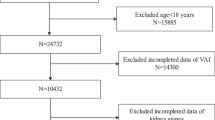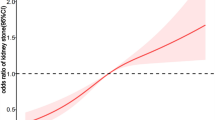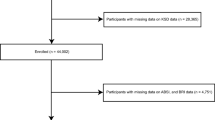Abstract
Obesity increases the risk of several diseases, including kidney stone disease (KSD). The study aimed to explore the relationship between KSD and various obesity-related indices. A total of 121,605 participants in the Taiwan Biobank from December 2008 to February 2020 were analyzed. The association between self-reported history of KSD and eight obesity-related indices, including body mass index (BMI), waist circumference (WC), waist-to-height ratio (WHtR), waist-to-hip ratio (WHR), abdominal volume index (AVI), body roundness index (BRI), conicity index, and triglyceride glucose index was examined in cross-sectional analysis; additionally, the risk of developing kidney stones was analyzed in a longitudinal cohort of 25,268 participants without KSD at baseline, which was a subset of the main cohort. Of all participants, 77,904 (64.1%) were female. Overall, 10.7% of males and 4.0% of females had KSD. Multivariate-adjusted logistic regression showed that all obesity-related indices were significantly associated with KSD. During a mean follow-up of 47 months, kidney stones occurred in 642 (2.5%) participants, and after adjusting for confounders, the risk of developing kidney stones was higher in participants with higher BMI, WC, WHtR, WHR, AVI and BRI. BMI, WC, WHtR, WHR, AVI, and BRI were found to be associated with a higher prevalence of kidney stones as well as development of incident kidney stones, which could be used as predictive factors for development of KSD in clinical practice.

Similar content being viewed by others
References
Foster G, Stocks C, Borofsky MS (2006) Emergency department visits and hospital admissions for kidney stone disease, 2009: Statistical brief #139. In: Healthcare cost and utilization project (HCUP) statistical briefs. Agency for Healthcare Research and Quality (US), Rockville, MD
Chung DY, Kang DH, Cho KS et al (2019) Comparison of stone-free rates following shock wave lithotripsy, percutaneous nephrolithotomy, and retrograde intrarenal surgery for treatment of renal stones: a systematic review and network meta-analysis. PLoS ONE 14(2):e0211316
Alelign T, Petros B (2018) Kidney stone disease: an update on current concepts. Adv Urol 2018:3068365
Carbone A, Al Salhi Y, Tasca A et al (2018) Obesity and kidney stone disease: a systematic review. Minerva Urol Nefrol (Ital J Urol Nephrol) 70(4):393–400
Chen T-F, Chen C-H, Lee Y-J (2018) The role of body mass index predicting outcome of percutaneous nephrolithotomy. Urol Sci 29(5):252–256
Taylor EN, Stampfer MJ, Curhan GC (2005) Obesity, weight gain, and the risk of kidney stones. JAMA 293(4):455–462
Poore W, Boyd CJ, Singh NP, Wood K, Gower B, Assimos DG (2020) Obesity and its impact on kidney stone formation. Rev Urol 22(1):17–23
Semins MJ, Shore AD, Makary MA, Magnuson T, Johns R, Matlaga BR (2010) The association of increasing body mass index and kidney stone disease. J Urol 183(2):571–575
Fontana L, Eagon JC, Trujillo ME, Scherer PE, Klein S (2007) Visceral fat adipokine secretion is associated with systemic inflammation in obese humans. Diabetes 56(4):1010–1013
Taylor SA, Hergenroeder AC (2011) Waist circumference predicts increased cardiometabolic risk in normal weight adolescent males. Int J Pediatr Obes IJPO Off J Int Assoc Study Obes 6(2–2):e307–e311
Shirasawa T, Ochiai H, Yoshimoto T et al (2019) Associations between normal weight central obesity and cardiovascular disease risk factors in Japanese middle-aged adults: a cross-sectional study. J Health Popul Nutr 38(1):46
Keys A, Fidanza F, Karvonen MJ, Kimura N, Taylor HL (1972) Indices of relative weight and obesity. J Chronic Dis 25(6):329–343
Guerrero-Romero F, Rodríguez-Morán M (2003) Abdominal volume index. An anthropometry-based index for estimation of obesity is strongly related to impaired glucose tolerance and type 2 diabetes mellitus. Arch Med Res 34(5):428–432
Valdez R, Seidell JC, Ahn YI, Weiss KM (1993) A new index of abdominal adiposity as an indicator of risk for cardiovascular disease. A cross-population study. Int J Obes Relat Metab Disorders J Int Assoc Study Obes 17(2):77–82
Hsieh SD, Yoshinaga H, Muto T (2003) Waist-to-height ratio, a simple and practical index for assessing central fat distribution and metabolic risk in Japanese men and women. Int J Obes Relat Metab Disorders J Int Assoc Study Obes 27(5):610–616
Pimenta NM, Santa-Clara H, Melo X, Cortez-Pinto H, Silva-Nunes J, Sardinha LB (2016) Waist-to-hip ratio is related to body fat content and distribution regardless of the waist circumference measurement protocol in nonalcoholic fatty liver disease patients. Int J Sport Nutr Exerc Metab 26(4):307–314
Nishida C, Ko GT, Kumanyika S (2010) Body fat distribution and noncommunicable diseases in populations: overview of the 2008 WHO expert consultation on waist circumference and waist-hip ratio. Eur J Clin Nutr 64(1):2–5
Thomas DM, Bredlau C, Bosy-Westphal A et al (2013) Relationships between body roundness with body fat and visceral adipose tissue emerging from a new geometrical model. Obesity (Silver Spring, MD) 21(11):2264–2271
Simental-Mendía LE, Rodríguez-Morán M, Guerrero-Romero F (2008) The product of fasting glucose and triglycerides as surrogate for identifying insulin resistance in apparently healthy subjects. Metab Syndr Relat Disord 6(4):299–304
Taylor EN, Curhan GC (2006) Body size and 24-hour urine composition. Am J Kidney Dis 48(6):905–915
Arsenault BJ, Beaumont EP, Després JP, Larose E (2012) Mapping body fat distribution: a key step towards the identification of the vulnerable patient? Ann Med 44(8):758–772
Chalmers D, Nicol D, Kaye J et al (2016) Has the biobank bubble burst? Withstanding the challenges for sustainable biobanking in the digital era. BMC Med Ethics 17(1):39
Sorensen MD, Chi T, Shara NM et al (2014) Activity, energy intake, obesity, and the risk of incident kidney stones in postmenopausal women: a report from the Women’s Health Initiative. J Am Soc Nephrol 25(2):362–369
Aune D, Mahamat-Saleh Y, Norat T, Riboli E (2018) Body fatness, diabetes, physical activity and risk of kidney stones: a systematic review and meta-analysis of cohort studies. Eur J Epidemiol 33(11):1033–1047
West B, Luke A, Durazo-Arvizu RA, Cao G, Shoham D, Kramer H (2008) Metabolic syndrome and self-reported history of kidney stones: the National Health and Nutrition Examination Survey (NHANES III) 1988–1994. Am J Kidney Dis 51(5):741–747
Pasdar Y, Moradi S, Moludi J et al (2020) Waist-to-height ratio is a better discriminator of cardiovascular disease than other anthropometric indicators in Kurdish adults. Sci Rep 10(1):16228
Lam BC, Koh GC, Chen C, Wong MT, Fallows SJ (2015) Comparison of body mass index (BMI), body adiposity index (BAI), waist circumference (WC), waist-to-hip ratio (WHR) and waist-to-height ratio (WHtR) as predictors of cardiovascular disease risk factors in an adult population in Singapore. PLoS ONE 10(4):e0122985
Bartani Z, Heydarpour B, Alijani A, Sadeghi M (2017) The relationship between nephrolithiasis risk with body fat measured by body composition analyzer in obese people. Acta Inf Med AIM 25(2):126–129
Taylor EN, Stampfer MJ, Curhan GC (2005) Diabetes mellitus and the risk of nephrolithiasis. Kidney Int 68(3):1230–1235
Rico-Martín S, Calderón-García JF, Sánchez-Rey P, Franco-Antonio C, Martínez Alvarez M, Sánchez Muñoz-Torrero JF (2020) Effectiveness of body roundness index in predicting metabolic syndrome: a systematic review and meta-analysis. Obes Rev 21(7):e13023
Sánchez E, Sánchez M, Betriu À et al (2020) Are obesity indices useful for detecting subclinical atheromatosis in a middle-aged population? Obes Facts 13(1):29–39
Xu J, Zhang L, Wu Q et al (2021) Body roundness index is a superior indicator to associate with the cardio-metabolic risk: evidence from a cross-sectional study with 17,000 Eastern-China adults. BMC Cardiovasc Disord 21(1):97
Akarken I, Tarhan H, Ekin RG et al (2015) Visceral obesity: a new risk factor for stone disease. Can Urol Assoc J 9(11–12):E795-799
Torricelli FC, De SK, Gebreselassie S, Li I, Sarkissian C, Monga M (2014) Dyslipidemia and kidney stone risk. J Urol 191(3):667–672
Daudon M, Traxer O, Conort P, Lacour B, Jungers P (2006) Type 2 diabetes increases the risk for uric acid stones. J Am Soc Nephrol 17(7):2026–2033
Borghi L, Meschi T, Guerra A et al (1999) Essential arterial hypertension and stone disease. Kidney Int 55(6):2397–2406
Lee YC, Huang SP, Juan YS, Huang TY, Liu CC (2016) Impact of metabolic syndrome and its components on kidney stone in aging Taiwanese males. Aging Male 19(3):197–201
Liu CC, Huang SP, Wu WJ et al (2009) The impact of cigarette smoking, alcohol drinking and betel quid chewing on the risk of calcium urolithiasis. Ann Epidemiol 19(8):539–545
Hamano S, Nakatsu H, Suzuki N, Tomioka S, Tanaka M, Murakami S (2005) Kidney stone disease and risk factors for coronary heart disease. Int J Urol 12(10):859–863
Zecher M, Guichard C, Velásquez MJ, Figueroa G, Rodrigo R (2009) Implications of oxidative stress in the pathophysiology of obstructive uropathy. Urol Res 37(1):19–26
Tamadon MR, Nassaji M, Ghorbani R (2013) Cigarette smoking and nephrolitiasis in adult individuals. Nephrourol Mon 5(1):702–705
Sakhaee K (2018) Unraveling the mechanisms of obesity-induced hyperoxaluria. Kidney Int 93(5):1038–1040
Taguchi K, Okada A, Hamamoto S et al (2015) Proinflammatory and metabolic changes facilitate renal crystal deposition in an obese mouse model of metabolic syndrome. J Urol 194(6):1787–1796
Khan SR (2014) Reactive oxygen species, inflammation and calcium oxalate nephrolithiasis. Transl Androl Urol 3(3):256–276
Amin R, Asplin J, Jung D et al (2018) Reduced active transcellular intestinal oxalate secretion contributes to the pathogenesis of obesity-associated hyperoxaluria. Kidney Int 93(5):1098–1107
Trinchieri A, Croppi E, Montanari E (2017) Obesity and urolithiasis: evidence of regional influences. Urolithiasis 45(3):271–278
Eisner BH, Eisenberg ML, Stoller ML (2010) Relationship between body mass index and quantitative 24-hour urine chemistries in patients with nephrolithiasis. Urology 75(6):1289–1293
Lemann J Jr, Pleuss JA, Worcester EM, Hornick L, Schrab D, Hoffmann RG (1996) Urinary oxalate excretion increases with body size and decreases with increasing dietary calcium intake among healthy adults. Kidney Int 49(1):200–208
Tsai L-H, Chang C-H, Chen S-J, Chen W-C (2019) Randall’s plaque, the origin of nephrolithiasis: where do we stand now? Urol Sci 30(5):200–205
Li WM, Chou YH, Li CC et al (2009) Association of body mass index and urine pH in patients with urolithiasis. Urol Res 37(4):193–196
Pigna F, Sakhaee K, Adams-Huet B, Maalouf NM (2014) Body fat content and distribution and urinary risk factors for nephrolithiasis. Clin J Am Soc Nephrol CJASN 9(1):159–165
Shoag JE, Patel N, Posada L et al (2019) Kidney stones and risk of narcotic use. J Urol 202(1):114–118
Siener R, Hesse A (2003) Fluid intake and epidemiology of urolithiasis. Eur J Clin Nutr 57(Suppl 2):S47-51
Chou YH, Li CC, Wu WJ et al (2007) Urinary stone analysis of 1,000 patients in southern Taiwan. Kaohsiung J Med Sci 23(2):63–66
Tanikawa C, Kamatani Y, Terao C et al (2019) Novel risk loci identified in a genome-wide association study of urolithiasis in a Japanese population. J Am Soc Nephrol 30(5):855–864
Littlejohns TJ, Neal NL, Bradbury KE, Heers H, Allen NE, Turney BW (2020) Fluid intake and dietary factors and the risk of incident kidney stones in UK Biobank: a population-based prospective cohort study. Eur Urol Focus 6(4):752–761
Acknowledgements
This work was supported partially by the Research Center for Environmental Medicine, Kaohsiung Medical University, Kaohsiung, Taiwan from The Featured Areas Research Center Program within the framework of the Higher Education Sprout Project by the Ministry of Education (MOE) in Taiwan and by Kaohsiung Medical University Research Center Grant (KMU-TC109A01-1).
Funding
No.
Author information
Authors and Affiliations
Corresponding author
Ethics declarations
Conflict of interest
The authors declare that they have no known conflict interests or personal relationships that could have appeared to influence the work reported in this paper.
Ethics approval
KMUHIRB-E(I)-20190398.
Consent to participate
All participants have signed a consent form and all investigations followed the Declaration of Helsinki.
Additional information
Publisher's Note
Springer Nature remains neutral with regard to jurisdictional claims in published maps and institutional affiliations.
Supplementary Information
Below is the link to the electronic supplementary material.
Rights and permissions
About this article
Cite this article
Lee, MR., Ke, HL., Huang, JC. et al. Obesity-related indices and its association with kidney stone disease: a cross-sectional and longitudinal cohort study. Urolithiasis 50, 55–63 (2022). https://doi.org/10.1007/s00240-021-01288-w
Received:
Accepted:
Published:
Issue Date:
DOI: https://doi.org/10.1007/s00240-021-01288-w




